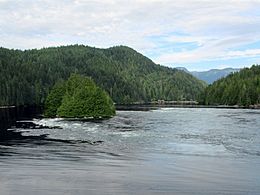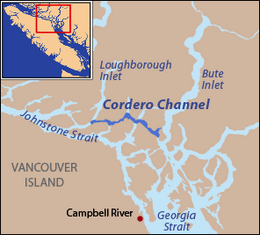Cordero Channel facts for kids
Quick facts for kids Cordero Channel |
|
|---|---|
| French: Canal Cordero | |

Dent Rapids, which flows east to west between the mainland coast and Sonora Island
|
|

Cordero Channel is part of a series of straits connecting the Strait of Georgia and Johnstone Strait
|
|
| Location | Strathcona RD, British Columbia |
| Coordinates | 50°26′N 125°33′W / 50.433°N 125.550°W |
| Type | Strait |
| Primary inflows | Bute Inlet |
| Primary outflows | Loughborough Inlet |
The Cordero Channel is a narrow waterway in British Columbia, Canada. It is located between the mainland and Vancouver Island. This channel is part of the Discovery Islands, which are found north of the Strait of Georgia.
Cordero Channel flows north of Sonora Island, East Thurlow Island, and part of West Thurlow Island. On its eastern side, it connects to the start of Bute Inlet and Calm Channel near Stuart Island. To the west, it meets Loughborough Inlet. After this point, the channel changes its name to Chancellor Channel, which then continues west to Johnstone Strait.
This channel is known for its strong currents. There are four main areas with fast-moving water, called tidal rapids. These rapids can be tricky to navigate. From east to west, they are Yuculta or Arran Rapids, Gillard Passage Rapids, Dent Rapids, and Greene Point Rapids.
Contents
How Cordero Channel Got Its Name
The Cordero Channel was named in 1792 during a Spanish exploration trip. The explorers Dionisio Alcalá Galiano and Cayetano Valdés y Flores named it Canal de Cardero. This was to honor José Cardero, who was the artist and mapmaker for their expedition.
Cardero sailed on Valdés's ship, the Mexicana. He had originally traveled from Spain with Alejandro Malaspina on the ship Descubierta. Cardero became an official artist for the expedition in Mexico in 1791. Like Galiano and Valdés, he was sent to explore the Strait of Georgia.
After their journey, Cardero helped Galiano prepare reports, maps, and drawings. Over time, the name Canal de Cardero changed to its current form, Cordero Channel. The area it referred to also grew larger. You can still find the name "Cardero" in Vancouver, where there is a street called Cardero Street. There is also a small fishing lodge called Camp Cordero at the north end of the channel.
Exploring the Channel: A Look Back at 1792
In 1792, the Spanish explorers Galiano and Valdés used different names for parts of what we now call Cordero Channel. For example, they called the section west of Phillips Arm Canal de Cardero. Other parts had names like Canal de Remolinos (Yuculta Rapids) and Angostura de los Commandantes (Arran Rapids).
Near Arran Rapids, the Spanish explorers found a large village. The local people were friendly and warned the Spanish about the strong currents and whirlpools in the rapids. When the tide slowed down, both the Spanish ships and many local canoes passed through. They entered what the Spanish called Canal de Carbajal.
The local people used signs to show the Spanish that this channel led to the sea. After this important discovery, the Spanish returned to their base. There, they met with the British expedition led by George Vancouver for the last time before meeting again at Nootka Sound. The Spanish shared their discovery of a passage to the sea. Soon after, a British scouting boat also found Johnstone Strait.
The two expeditions then went their separate ways on July 13, 1792. The British sailed through Discovery Passage and Johnstone Strait. The Spanish chose to go through Cordero Channel, Chancellor Channel, and Wellbore Channel. Galiano's report says that Vancouver thought Cordero Channel was too dangerous for his ships.
On July 13, 1792, the Spanish ships left their anchorage near West Redonda Island and Cortes Island. They sailed towards Cordero Channel. They traveled up Calm Channel and around the east side of Stuart Island. On July 18, they finally reached Arran Rapids, which was the entrance to Cordero Channel.
The explorers had trouble entering the channel because of the strong currents. On July 19, they met another group of local people. These people were catching many fish in the strait. With their help, the Spanish learned more about the currents. They then made a plan to pass through.
When the tide slowed down that afternoon, the Spanish ships entered. However, the current was still strong, making it hard to steer. At one point, Galiano's ship, the Sutil, got caught in a whirlpool but managed to escape. Later that evening, near Dent Island, they anchored in a small bay. They named this bay Anclage del Refugio. They called the first part of Cordero Channel Angostura de Carvajal and Canal de Carvajal. This was in honor of Ciriaco Gonzales Carvajal, a Spanish Navy auditor.
The Spanish also had difficulty passing Dent Rapids. They finally managed to do so on July 23. They were visited again by the same friendly local people they had met at Arran Rapids. These "good Indians" again offered advice about the currents. They also suggested the best route for the Spanish ships. The local people even made maps for the Spanish. They showed which channels were closed inlets and which led to the sea. They made these maps by using books as a surface and pencils on paper.
After reaching the northern end of Nodales Channel, between Sonora Island and East Thurlow Island, the Spanish decided to continue west. They followed what is now Cordero Channel. They called this section Canal del Engaño. On July 26, they quickly moved into another part of Cordero Channel they called Canal de Olavide. The current then carried them into the section they called Canal de Cardero. They could not steer or use their oars. By the end of the day, they were able to anchor at the mouth of Loughborough Inlet, which they called Canal de Salamanca.
On July 27, 1792, the Spanish ships left their anchorage at Viana. They entered what is now called Chancellor Channel, leaving Cordero Channel behind. When they reached Hardwicke Island, they turned northwest. They left Chancellor Channel for Wellbore Channel, which they called Canal de Nuevos Remolinos. This channel led them to Sunderland Channel and finally to Johnstone Strait.
See also
 In Spanish: Canal Cordero para niños
In Spanish: Canal Cordero para niños


